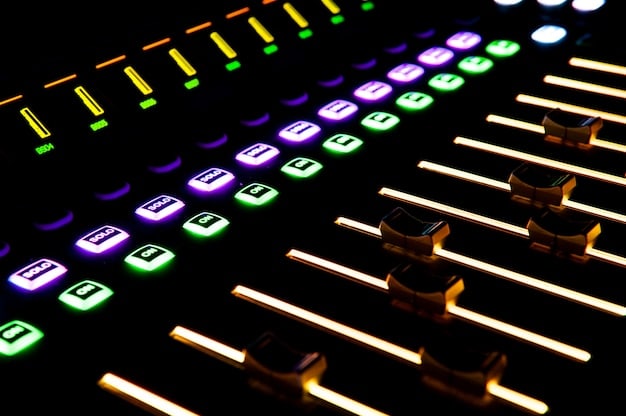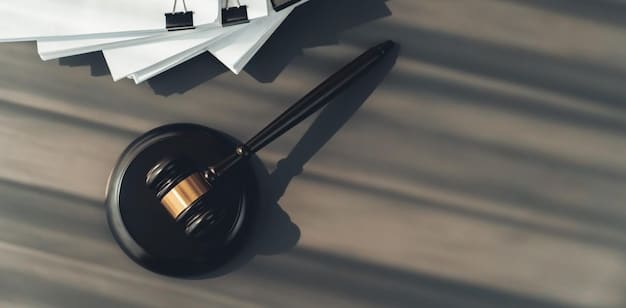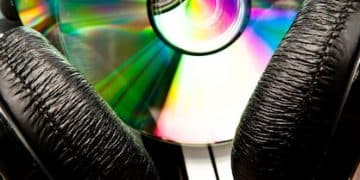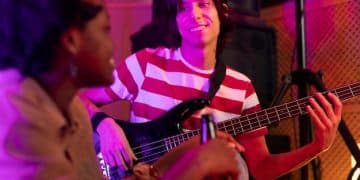Independent Labels: Protecting Your Music from Copyright Infringement

Independent Labels: How to Protect Your Music from Copyright Infringement involves understanding copyright law, registering your music, using watermarks and digital fingerprinting, monitoring usage, and taking legal action when necessary to defend your rights.
Navigating the music industry as an independent label can be exhilarating, but it also requires a keen understanding of copyright law. Protecting your music from infringement is crucial to safeguarding your creative work and financial investments. This article provides essential guidance on Independent Labels: How to Protect Your Music from Copyright Infringement effectively.
Understanding Copyright Law for Independent Labels
Copyright law is the bedrock of music protection. It grants creators exclusive rights over their original works, preventing unauthorized use, distribution, or modification. For independent labels, understanding these rights is the first line of defense against infringement.
Let’s dive into some key aspects of copyright law relevant to independent labels:
What Copyright Protects
Copyright protects various elements of music, including:
- Musical Compositions: The melody, harmony, and rhythm of a song.
- Sound Recordings: The specific recorded performance of a song.
- Lyrics: The words of a song.
- Arrangements: Unique arrangements or adaptations of existing songs.
Copyright Ownership
Typically, the composer and lyricist own the copyright to the musical composition, while the recording artist and label own the copyright to the sound recording. Clear agreements and contracts are vital to establish ownership and avoid disputes.

Understanding these fundamental aspects of copyright law is essential for independent labels. It sets the stage for implementing proactive measures to protect their music and secure their rights.
In conclusion, understanding copyright law provides a foundation for independent labels to protect their assets. By knowing what is protected and who owns the rights, labels can proactively defend their music and ensure proper compensation.
Registering Your Music with the U.S. Copyright Office
Registering your music with the U.S. Copyright Office offers significant legal advantages. It creates a public record of your copyright claim and allows you to sue for infringement in federal court. While copyright protection exists from the moment a work is created, registration enhances your ability to enforce your rights.
Here’s why and how to register your music:
Benefits of Copyright Registration
- Legal Recourse: Registration is required to file a copyright infringement lawsuit in federal court.
- Statutory Damages: Registered works may be eligible for statutory damages and attorney’s fees in infringement cases, which can significantly increase the potential recovery.
- Public Record: Registration creates a public record of your copyright claim, deterring potential infringers.
How to Register Your Music
The U.S. Copyright Office offers online registration through its website. The process involves:
- Creating an account on the Copyright Office website.
- Completing the online application form.
- Uploading a copy of your music.
- Paying the registration fee.
Timing of Registration
Registering your music promptly is crucial. To maximize your legal options, register your work:
- Within three months of publication.
- Before any infringement occurs.
Registering your music with the U.S. Copyright Office is a pivotal step in protecting your work. It provides concrete legal advantages and strengthens your ability to defend your rights in case of infringement.
To summarize, copyright registration provides significant legal advantages, including the ability to sue for infringement in federal court and potentially recover statutory damages. Registering promptly after publication is crucial to maximize these benefits.
Watermarking and Digital Fingerprinting Techniques
Watermarking and digital fingerprinting are proactive methods to protect your music. These techniques embed information within the audio file itself, making it easier to track and trace unauthorized usage. They serve as digital signatures, helping you monitor and enforce your copyright.
Let’s explore each technique:

Digital Watermarking
Digital watermarking involves embedding a subtle, often inaudible, code into the audio file. This code can contain information about the copyright owner, the terms of use, or other identifying details.
Here are some key benefits:
- Copyright Identification: Watermarks clearly identify the copyright owner.
- Usage Tracking: They enable tracking of where and how the music is being used.
- Deterrence: The presence of a watermark can deter potential infringers.
Digital Fingerprinting
Digital fingerprinting creates a unique “fingerprint” of the audio file based on its acoustic characteristics. This fingerprint can be used to identify the music, even if it has been altered or compressed.
How it works:
- The system analyzes the audio file.
- It creates a unique digital fingerprint.
- This fingerprint is stored in a database.
- The database is used to identify the music in various online platforms.
Implementing watermarking and digital fingerprinting provides robust protection for your music. These techniques help you track usage, identify infringement, and assert your copyright effectively.
In conclusion, watermarking and digital fingerprinting are proactive measures that provide robust protection for your music. These techniques embed identifying information within the audio file, helping you track usage and deter infringement.
Monitoring Online Platforms for Copyright Infringement
Regularly monitoring online platforms is essential to detect and address copyright infringement. The internet has made it easier than ever for music to be distributed, but also easier for unauthorized copies to spread. Using various tools and strategies can help you stay vigilant.
Here are some effective methods for monitoring:
Using Automated Monitoring Tools
Several automated tools can scan online platforms for unauthorized use of your music. These tools use digital fingerprinting and other technologies to identify matches.
Examples include:
- YouTube’s Content ID: A system that automatically identifies and manages copyrighted content.
- Audible Magic: A service that monitors audio content across various platforms.
- TuneSat: A tool that tracks music usage in television and radio broadcasts.
Manual Monitoring Strategies
In addition to automated tools, manual monitoring can be valuable. This involves regularly searching for your music on popular platforms and forums.
Strategies include:
- Searching for song titles and artist names on YouTube, Spotify, and SoundCloud.
- Checking file-sharing websites and forums.
- Monitoring social media platforms for unauthorized uploads.
- Documenting any instances of infringement with screenshots and URLs.
- Contacting the platform to request removal of the infringing content.
- Consulting with a copyright attorney to discuss further legal action, if necessary.
By combining automated tools with manual monitoring, you can effectively detect and address copyright infringement. This proactive approach helps protect your music and ensures that you are compensated for its use.
In summary, monitoring online platforms regularly is crucial for detecting and addressing copyright infringement. Using automated tools and manual searches provides a comprehensive approach to safeguarding your music’s copyright.
DMCA Takedown Notices and Legal Action
When you discover copyright infringement, taking prompt and decisive action is vital. The Digital Millennium Copyright Act (DMCA) provides a legal framework for addressing online infringement. Sending DMCA takedown notices and, if necessary, pursuing legal action are essential steps in protecting your rights.
Here’s a breakdown of the process:
Sending DMCA Takedown Notices
A DMCA takedown notice is a formal request to an online service provider (e.g., YouTube, Facebook) to remove infringing content. The notice must comply with specific requirements under the DMCA.
Key elements include:
- Identifying the copyrighted work that has been infringed.
- Identifying the infringing material and its location on the platform.
- Providing contact information for the copyright owner.
- Including a statement that you have a good faith belief that the use of the material is not authorized.
- Including a statement, under penalty of perjury, that the information in the notice is accurate and that you are authorized to act on behalf of the copyright owner.
Pursuing Legal Action
If a DMCA takedown notice is not effective, or if the infringement is particularly egregious, you may need to pursue legal action. This can involve filing a lawsuit in federal court against the infringer.
Legal remedies can include:
- Injunctions: Court orders prohibiting further infringement.
- Damages: Monetary compensation for the harm caused by the infringement, including actual damages and, in some cases, statutory damages.
- Attorney’s Fees: Reimbursement of legal expenses.
Taking swift and decisive action against copyright infringement is essential for protecting your music. DMCA takedown notices and legal action are powerful tools for enforcing your rights and deterring future infringement.
In conclusion, sending DMCA takedown notices and pursuing legal action are essential steps when addressing copyright infringement. These actions enforce your rights and deter future infringement, protecting your music’s value.
Educating Artists and Staff on Copyright Best Practices
Protecting your music also involves educating your artists and staff on copyright best practices. A well-informed team is more likely to respect copyright laws and avoid unintentional infringement. This education is crucial to creating a culture of copyright compliance within your independent label.
Key areas to cover include:
Training Sessions and Workshops
Conducting regular training sessions and workshops can help artists and staff understand copyright law and best practices. These sessions can cover topics such as:
- Copyright basics: What it protects and how it works.
- Fair use: Understanding the limitations on copyright protection.
- Licensing: How to obtain permission to use copyrighted material.
- Avoiding infringement: Best practices for creating original content.
Developing Internal Policies
Creating clear internal policies regarding copyright compliance can help ensure that everyone is on the same page. These policies should address issues such as:
- Procedures for clearing samples and other copyrighted material.
- Guidelines for using social media and online platforms.
- Protocols for handling copyright infringement claims.
By creating a culture of copyright compliance, you can minimize the risk of infringement and protect your music effectively. Educating artists and staff is an investment that pays dividends in the long run.
In conclusion, educating artists and staff on copyright best practices is important for fostering a culture of copyright compliance. Regular training sessions and clear internal policies will minimize the risk of infringement.
| Key Point | Brief Description |
|---|---|
| 🎵 Copyright Law | Understand what copyright protects and who owns the rights. |
| 📄 Registration | Register your music to gain legal recourse and statutory damages. |
| 🛡️ Watermarking | Use watermarks and digital fingerprints to track and deter infringement. |
| 🔎 Monitoring | Regularly monitor online platforms for unauthorized use. |
Frequently Asked Questions
▼
Copyright infringement is the unauthorized use, reproduction, distribution, or creation of derivative works based on a copyrighted work. It violates the exclusive rights granted to the copyright owner under federal law.
▼
To prove copyright infringement, you must show ownership of a valid copyright and demonstrate that the infringing party copied your work without permission. Evidence can include direct copying or substantial similarity.
▼
Statutory damages are a fixed amount of money awarded by a court in copyright infringement cases when actual damages are difficult to prove. The amount varies based on the nature of the infringement.
▼
A DMCA takedown notice is a legal notification sent to an online service provider, such as YouTube or Facebook, requesting the removal of infringing content that violates copyright laws.
▼
Educating artists helps prevent unintentional copyright infringement. When artists understand copyright law, they are more likely to respect the rights of others and protect their own work.
Conclusion
Protecting your music as an independent label requires a multifaceted approach, from understanding copyright law to actively monitoring online platforms. By implementing these strategies, you can safeguard your creative work, enforce your rights, and ensure that your music is properly valued and protected.





